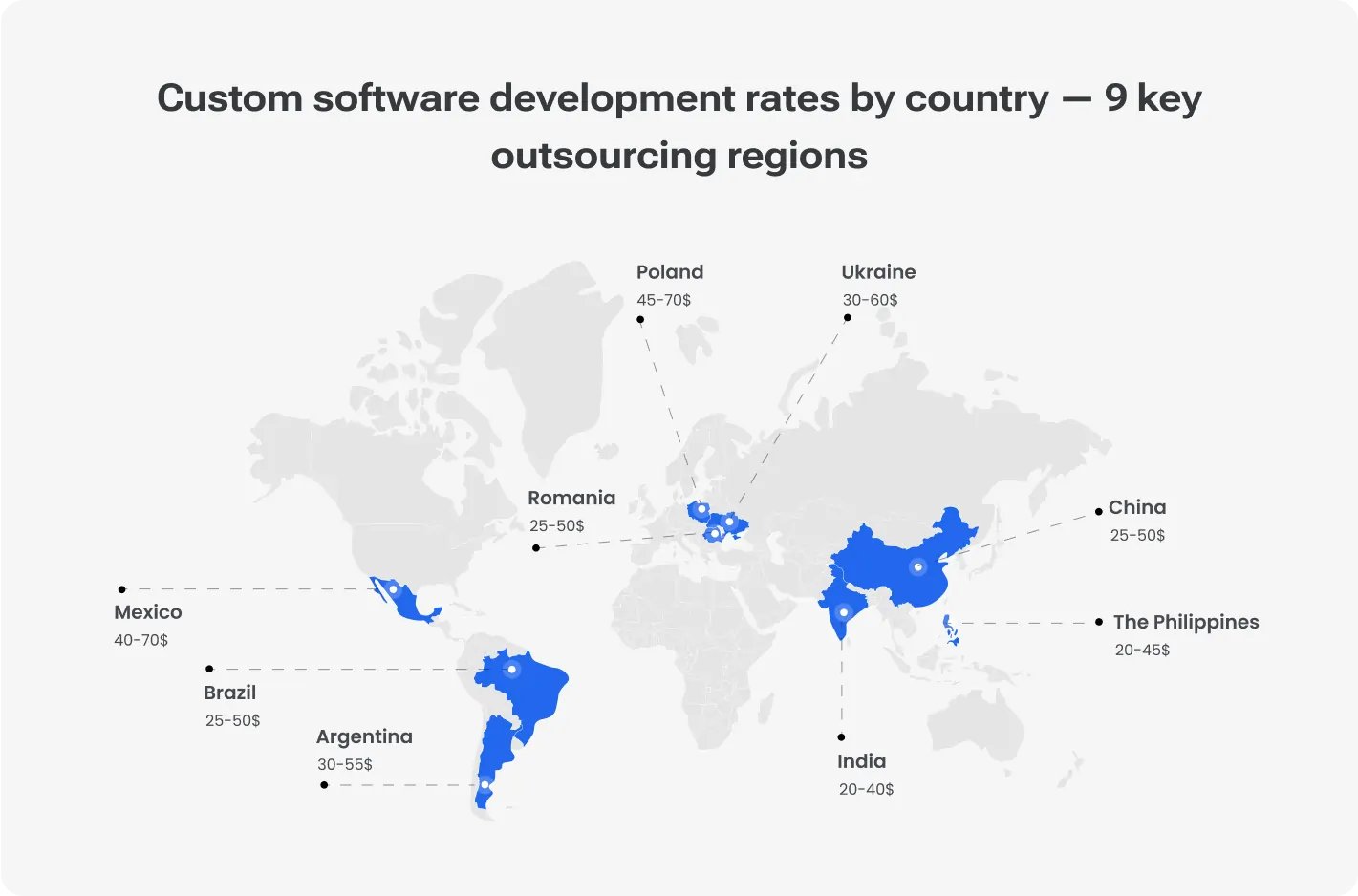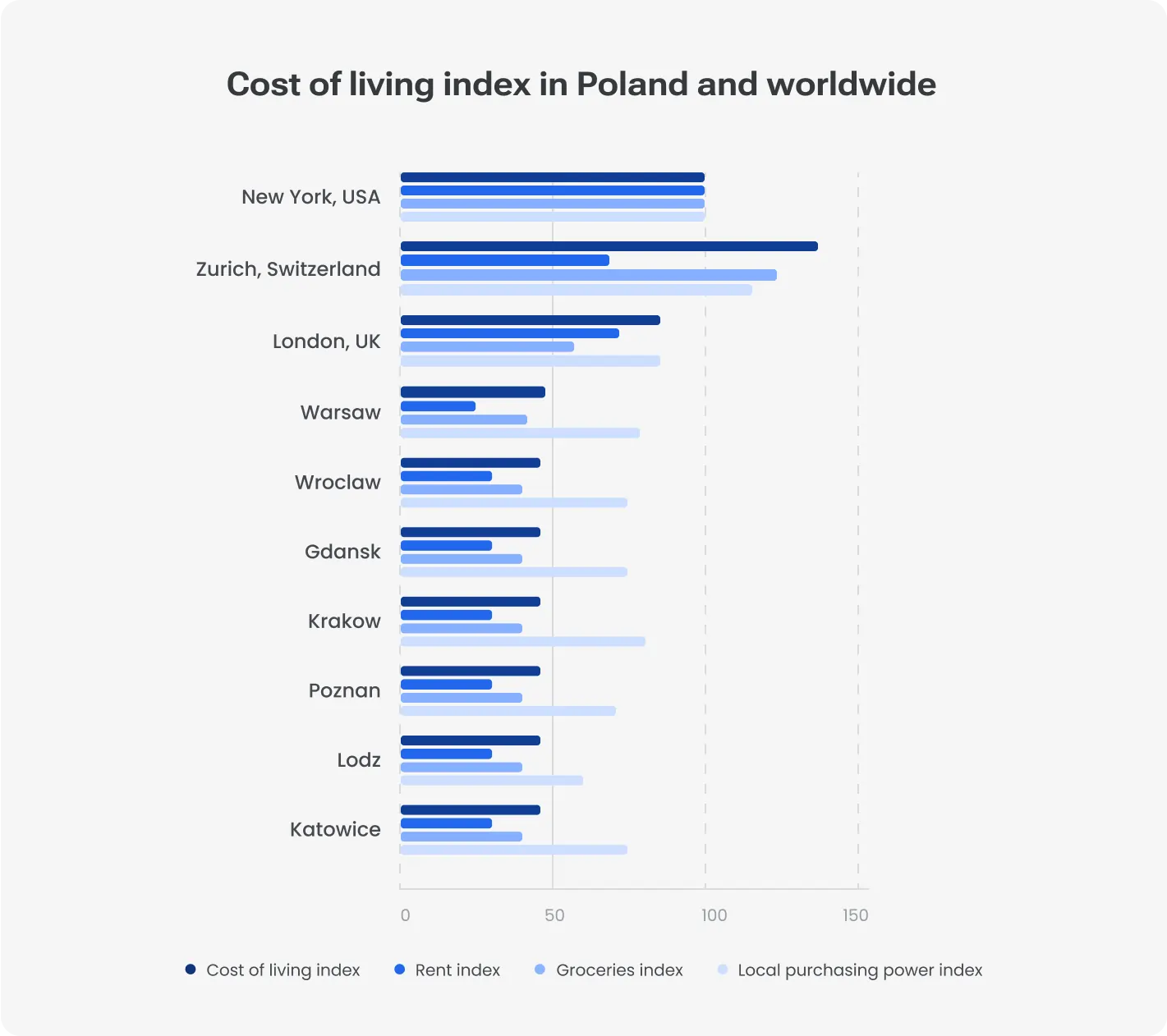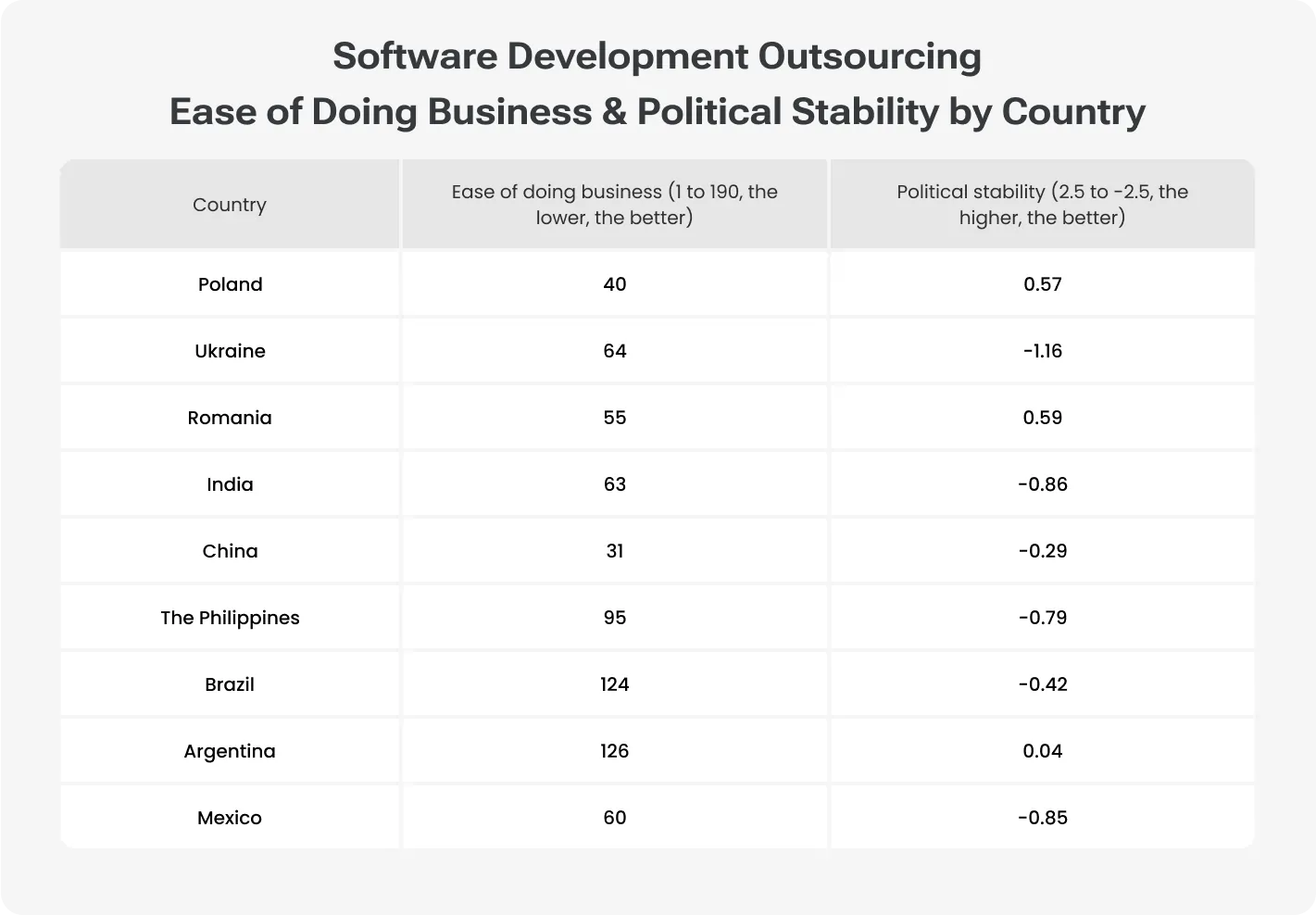In-house equals significant investments in recruitment, training, and infrastructure, and these costs typically quickly escalate. That’s why businesses seek ways to optimize their software development processes.
Outsourcing to Poland is one such way that offers a leaner model and allows businesses many benefits.
Two compelling points stand out. First, companies gain immediate access to highly skilled professionals, bypassing lengthy hiring cycles. Second, they can reallocate critical resources toward core business innovation.
In the following sections, we’ll explore additional factors and detailed data that explain why the cost of the IT outsourcing market in Poland remains so competitive. As well as compare pricing models with other global markets and discuss key cost drivers — from developer experience to project complexity.
Software outsourcing in Poland is still a wise move for your development needs. Why? Let’s break it down.
Flexible staff augmentation and expert software developers in Poland
Software development costs in Poland: Actual breakdown
Software development rates in Poland 2025
The total cost of outsourcing to Poland doesn’t stop at rates alone — it consists of several factors.
We are not about to talk you into it, just to clarify: there is a 15:1 ratio between the highest (Switzerland at USD 165/hour) and lowest (Philippines at USD 10/hour) rates.
The calculation may seem complicated, and that’s why many foreign entrepreneurs give up such a promising destination.
Many, but not you. Because you know Polish outsource rates.
Junior developers (0-2 years): USD 20 to USD 30 per hour. Hire them for well-defined, lower-risk tasks or as part of larger agile teams to support evolving projects.
Mid-level developers (3-5 years): USD 35 to USD 50 per hour. The mix of cost efficiency and reliability, which makes it suitable for moderate projects and those requiring some level of innovation.
Senior developers (6+ years): USD 65 to USD 90 per hour depending on the technology stack and industry demand. Hire them for leading projects and apps with complex architecture.
Specialized roles: Usually higher rates than specified above: USD 90 to USD 120 per hour. But with them, you get expertise in complex, innovative solutions.
Hourly vs. project-based pricing
Weight up your goals, budget, and other relevant factors. Then, choose a suitable model. Here is what they are all about.
Hourly pricing
Does your project rapidly change scopes? Do you need flexibility for other reasons? Hourly pricing perfectly fits the agile environment.
This model is flexible and adjustable and is even more suitable for MVP-staged startups or companies scaling digital transformation initiatives. Hourly pricing is also relevant for long-term projects where requirements may change over time.
Project-based pricing
Best suited for well-defined projects with clear requirements and deliverables — companies in the planning phase or those seeking a fixed budget for development. With project-based pricing, the total cost is agreed upon upfront, reducing financial uncertainty.
Fixed price vs. time and material vs. dedicated team
In addition to the pricing method (hourly vs. project-based), the overall pricing model further defines the engagement.
Fixed price
This means that whatever changes, the total cost remains as agreed. No changes are expected? So, this model may work best for you. Fixed pricing offers budget certainty but can be inflexible in terms of unexpected challenges.
Time and material
This model bills clients based on the actual hours worked and materials used. Particularly beneficial for projects with dynamic scopes, where you expect frequent evolution of the requirements. Way more flexible model that ensures clients only pay for the work completed.
Dedicated team
You don’t share your dedicated software development team with anybody else. Developers work exclusively on a client’s project over a longer period. Suitable for companies with ongoing development needs, as well as for those looking for a strategic partner rather than a one-off vendor. Allows for better integration with the client’s existing processes and ensures a high degree of collaboration.
Hidden costs
In an ideal world, you won’t expect any twists. Yet, we don’t live in an ideal world. For this reason, take into account some possible hidden (or just unnoticeable) costs.
Infrastructure: Hardware, software licenses, cloud services — all these support the development process and require some money.
Management: Project oversight, team coordination, and quality assurance require dedicated management resources.
Legal and compliance fees: All is clear, we assume. Adherence to both local and international regulations (remember intellectual property rights) and data protection pose some financial obligations on both sides of the agreement.
Communication overhead: Meetings also count, and sometimes they cost a fortune. Collaboration tools and potential time zone coordination efforts add up to administrative costs.
Integration and maintenance: Post-development integration with existing systems and ongoing maintenance can incur additional charges.
Travel and onsite expenses: In some cases, occasional travel for face-to-face meetings or onsite support may be necessary. Be ready to pay.
Poland vs. other IT outsourcing destinations: cost comparison
You shouldn’t stop at hourly rates only. The cost of outsourcing to Poland goes beyond it as you should understand the full picture of quality and productivity. Especially because rates themselves vary drastically across regions.
Poland vs. India: What to choose for software development outsourcing?
Poland
Junior: ~USD 20 - USD 30/hour
Mid-level: ~USD 35 - USD 50/hour
Senior: ~USD 65 - USD 90/hour
Specialized roles (e.g., AI, blockchain): ~USD 90 - USD 120/hour
India
Junior: ~USD 15 - USD 25/hour
Mid-level: ~USD 25 - USD 40/hour
Senior: ~USD 40 - USD 60/hour
Specialized roles: ~USD 60 - USD 80/hour
Ukraine
Junior: ~USD 20 - USD 35/hour
Mid-level: ~USD 35 - USD 55/hour
Senior: ~USD 55 - USD 75/hour
Specialized roles: ~USD 75 - USD 100/hour
Latin America
Junior: ~USD 20 - USD 30/hour
Mid-level: ~USD 30 - USD 50/hour
Senior: ~USD 50 - USD 70/hour
Specialized roles: ~USD 70 - USD 90/hour
Western Europe
Junior: ~USD 40 - USD 50/hour
Mid-level: ~USD 60 - USD 70/hour
Senior: ~USD 90 - USD 120/hour
Specialized roles: ~USD 120 - USD 150/hour
Quality vs. cost trade-offs and developer productivity
India and Ukraine may offer lower hourly rates. Yet, the quality and devs’ productivity usually offset the slightly higher cost of IT outsourcing services in Poland.
Local developers are known for their strong technical skills (unpopular languages, advanced testing frameworks, AI/ML, etc), proficiency in English (B2-C1 on average according to the English Proficiency Index), and adherence to Western business practices.
Higher productivity + fewer communication barriers = more efficient project execution.
There is no authoritative data or statistics proving Poland’s software quality is “quality-er” than software from other vendors. However, there is another piece of evidence — just look at their robust educational system and how hard they invest in tech infrastructure.
Their universities steadily supply local companies with skilled developers, and companies, in turn, ensure the latest tech infrastructure and advanced tools for high performance.
Poland’s cost-efficiency for nearshoring vs. offshoring
Sizing up the option to nearshore or offshore software development in Poland? Let’s briefly run through two factors.
-
Location: Poland is in the Central European Time Zone, which makes it an ideal nearshoring destination (if your company operates within Europe). Minimal time difference, real-time collaboration, faster decision-making processes, total agility, and stuff.
-
Culture: Offshore development in Poland takes other destinations apart. Okay, let’s say, it has more advantages over other destinations. India and Southeast Asia usually challenge clients with time zone differences, cultural barriers, and a higher demand for control.
Poland’s competitive rates and high-quality talent make it the main choice for companies striving for a perfect cost-efficiency balance.
What drives software development costs in Poland?
There are four key factors that contribute to the overall cost of outsourcing to Poland.
Developer expertise and tech stack
Well-educated, fast on the uptake people with good gut on emerging advancements and deep expertise in technologies.
AI/ML: In some senses, these are premium specialists. They drive innovation… and often remote AI engineers command steep rates due to the complexity of AI projects.
Full-stack development: Includes front-end and back-end frameworks — for versatile solutions.
The more complex your idea or product is the larger the budget you need to set. In terms of quality-cost balance, Poland as a destination seems more than adequate.
Project complexity and duration
The project in any industry starts with understanding the current position and setting goals. Then, we usually define the project scope and responsibilities. Depending on our initial data we forecast the project’s duration. Returning to outsourcing to Poland, there are typically two scenarios.
-
Short-term projects: Usually applied by startups at the MVP stage or for proof-of-concept applications. Commonly priced on an hourly or fixed-price basis.
-
Long-term projects: Often involve complex architectures with higher investments, iterative improvements, and maintenance overhead.
Location within Poland
As we stated, software development rates in Poland in 2025 are quite competitive, but keep in mind regional disparities.
Warsaw: Higher rates reflect a higher cost of living and greater access to top-tier talent.
Krakow and Wroclaw: Offer a balance of quality and cost efficiency, with strong local tech ecosystems and renowned universities.
Smaller cities: Often present lower rates while still providing quality services.
A tip: Before entering the market and hiring Polish developers, find a local fellow who knows the ropes of the Polish IT industry. For a particular commission, he could suggest local software houses, particular specialists, and sometimes could help negotiate better rates.
Regulatory and tax considerations
We can’t help but admit that compliance with local (and international, of course) regulations influences the total costs.
Legal fees: Apart from the European Union data protection and intellectual property laws, you should take into account 19% CIT (corporate income tax) on Polish-sourced income and a minimum tax liability of 10% if profitability <2% (effective 2024).
Tax incentives and obligations: You can benefit from special tax treatment. For example, a 200% write-off for qualified R&D expenses or 0% CIT in Special Economic Zones for the first 10 years (e.g., Krakow Tech Park).
Infrastructure investments: Compliance often necessitates investments in secure data centers, advanced cybersecurity measures, and advanced development tools.
Some current regulatory trends:
Digital services tax: Proposed 3% levy on SaaS/cloud revenue >EUR 750k/year (2026 draft).
AI development credits: 15% tax rebate for AI/ML projects using Polish R&D centers.
Anti-hybrid rules: Limiting deductions for offshore-parented IT service chains.
How to optimize your outsourcing budget in Poland
Optimizing is all about maximizing value while minimizing risks and unnecessary spending. Let’s go through key strategies on this matter.
Agile project management
Agile methodologies reduce rework and enhance teamwork. The more clearly you set project requirements, the fewer iterations you will complete and the more precise the result.
Such an approach to development cycles allows you to continuously adjust priorities and prevent scope creep and unnecessary expenditures. Start with essential features, set the right priorities, and keep monitoring the total business value — this will help you lower the cost of outsourcing to Poland.
How to choose the best outsourcing software development company in Poland?
Right engagement model
We’ve already described every model in detail above. Here is just a quick reiteration: Size up your project’s requirements and the resources you have at the moment. Then, choose the most relevant engagement.
1/ Fixed price:
Have clearly defined scopes and understand what you actually want to achieve? This model provides budget certainty and is suitable for small to medium-sized projects with minimal changes expected.
Best for: Startups or businesses with limited flexibility in budgeting.
2/ Time and material:
Do you expect swaying requirements or are you unsure about the end scope? T&M offers flexibility in scaling resources up or down.
Best for: Agile development environments where changes are frequent and welcomed.
3/ Dedicated team:
Hire Polish developers solely for your project. This way, you ensure confidence in planning and deep project understanding from the vendor’s end. The model better serves long-term projects or ongoing development needs.
Best for: Companies with a consistent development pace.
Long-term partnerships
Domain expertise: A long-standing relationship allows the development team to gain a thorough understanding of your business, leading to more tailored and effective solutions.
Cost efficiency: Reduced onboarding and training costs, along with the ability to negotiate better terms over time, contribute to lower overall expenses.
Continuity: Continuous collaboration fosters innovation, as the team is more motivated to contribute to your business’s success.
Software development in Poland could become the best investment for your company if you take a proactive approach to managing your engagement model and do enough homework to choose the best partner.
Devico: Your trusted partner for software development in Poland
IT outsourcing in Poland has grown exponentially: 1K+ new companies have sprung up in the last five years. Devico tackles the competition with technical expertise, pricing transparency, and robust cost efficiency.
Expertise and transparency
Deep industry knowledge and a comprehensive range of services: we operate in any model we observe within this article.
Moreover, we offer BOT, augmentation, and developing a separate remote R&D center in a safe and stable part of Europe. This allows us to meet diverse project requirements, and ensure that you get the best value for your investment.
Be sure about the cost of outsourcing to Poland with our detailed pricing breakdowns and clear communication.
Conclusion
Many factors influence the total cost of outsourcing to Poland. Yet, it’s not a big deal since the costs are more predictable and stable than in other European destinations. You can plan and set the budget beforehand.
What to consider, if you want to hire Polish developers:
-
The strategic location within Europe.
-
Like-minded companies similar to Western business mindset.
-
Robust infrastructure.
Despite rising salaries and infrastructure spending, the Polish outsource rate offers more predictable outcomes and still seems better in terms of cost-effectiveness.
Contact Devico to conduct an intro call. We’d like to learn more about your needs, business nuances, and requirements. Let’s see how we can help you.
Tap into Poland’s tech expertise with a time-to-market advantage and up to 50% budget savings






